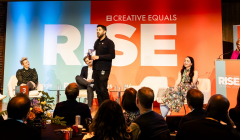
Are we leaving men and boys behind?
At Creative Equal’s RISE event, industry leaders consider how to reframe boys and men in marketing

Instead of urging women to ‘fight’ the signs of ageing, smart brands are meeting women where they are.

For many women, recent years have brought about a much welcome reckoning for the beauty industry. Brands and agencies alike are embracing the need for better representation and a celebration of diverse forms of beauty. Whilst consumers are welcoming the ability to see more of themselves represented by the products they buy.
Despite the progress, when it comes to ageing and reflecting the reality of older women, there’s still a lot of work to do. The psychology behind it is something called Terror Management Theory. Humans have a deep-rooted psychological fear of death and ageing. We try and counteract this fear through ageist attitudes, allowing us to feel far away from the fear ‘othering’ the older, in our language, our perceptions and our prejudice. 61% of menopausal women in the UK believe that ‘society expects them to vanish from public life as they get older’ and 74% feel that ads fail to portray women in this phase of life with any sensitivity (BOF). On the shelf, there’s still an array of lotions and potions promising to “fight the signs of ageing” - making eternal youth feel like the ultimate goal and leaving menopausal women feeling invisible.
As the marketing industry, we need to make them feel seen - but if brands are serious about driving real change, comms campaigns alone can’t make the difference. It’s not enough to just tick the box of having older women in imagery; brands need to authentically include them in everything from their boardrooms to their NPD.
Despite the progress, when it comes to ageing and reflecting the reality of older women, there’s still a lot of work to do.
Emma Grace, Executive Creative Director and Co-CEO at PrettyGreen Group
Our client Pantene did just that when it launched its Hair Biology Menopause Range. The products were created to manage the effects of Menopause on hair, including dry scalp, thinning hair or even hair loss. It wasn’t about reversing or hiding the menopause, but instead helping women to embrace the changes they were experiencing and feel their best doing it.
When we were briefed for the launch, we knew we wanted to do the range justice with a campaign that celebrated women in older life as much as the product did. We built the creative around a core consumer insight that women of menopausal age often start to mute their hair. They cut it shorter, they are less brave with colour, and they choose more conservative styles because they are afraid that society will deem their look inappropriate or like ‘mutton dressed as lamb’. With our campaign we refuted this, encouraging women to question why they were adhering to these unwritten societal standards and celebrating those who stuck two fingers up to the rules and had their hair however they liked. The #MyHairWontBeSilenced campaign was born.
One thing we were clear on is that we wanted to involve older women at every stage of the development. Firstly, we made sure that the internal team working on it was made up of 46% women over 40 - this was really important to us as we know authentic representation starts behind the scenes. We also carried out research to validate the prevalence of ageist language and rules in hair appearance to really understand the impact for the audience and inform the direction of the creative. For the campaign imagery, we partnered with vibrant female, midlife photographer Elizabeth Hoff to create a collection of protest images of women that refuse to be invisible in mid-life. The images featured three real women and menopausal content creators who had lived experience of hair discrimination and ageism. They shared their menopause hair stories for media and on their own social channels to start the conversation and we partnered with Loose Women presenter and menopause activist Nadia Sawalha to spread the word further on a bigger stage.
The campaign had great success achieving 47 pieces of coverage with an online reach of over 1.6 billion and print circulation of 4 million and the social content achieved a reach of over 800 thousand. The campaign kickstarted a conversation around celebrating women at all stages of their life, not just the time where there’s no greys or wrinkles. But, what we’re really proud of is how we challenged ourselves and our client to not just do representation for representations sake. In trying to portray a more diverse depiction of society in campaigns it’s easy to fall into gimmicks or cliches, but by consulting and working side by side with the audience we were trying to reach at every stage, we were able to meet our audience where they were and speak to them authentically - making representation truly more than just skin deep.
Emma Grace has been leading the creative development of integrated campaigns across PR, Influencer, Social, Experiential and Content for over two decades. Emma plays a dual role within PrettyGreen Group of ECD & CO-CEO, overseeing the creative and strategic output of the agency and spearheading the Less Ordinary vision and running of the group. Emma has a particular passion for purpose led work, which has led to award winning campaigns for Pantene & Hopster.
Looks like you need to create a Creativebrief account to perform this action.
Create account Sign inLooks like you need to create a Creativebrief account to perform this action.
Create account Sign in